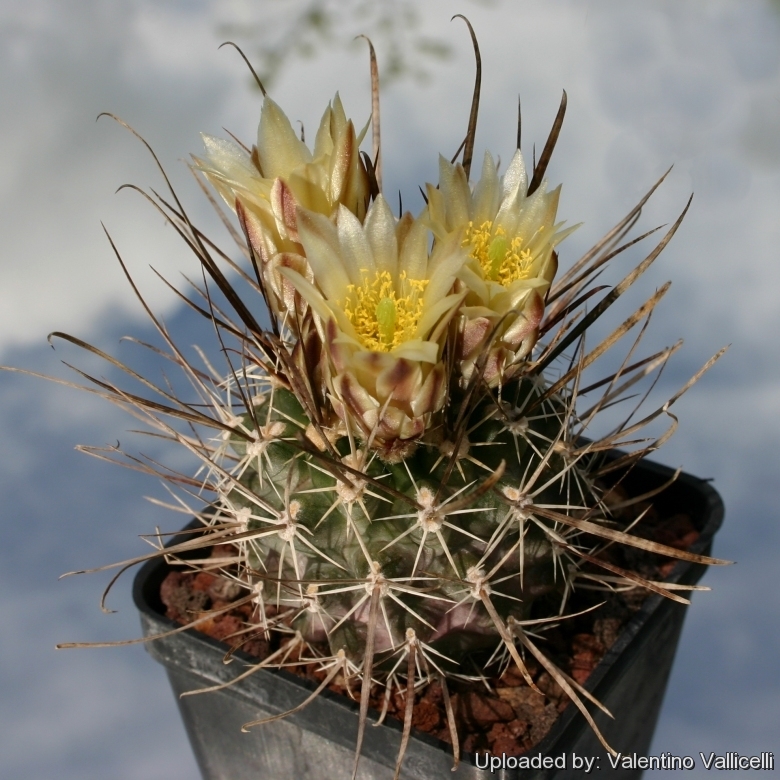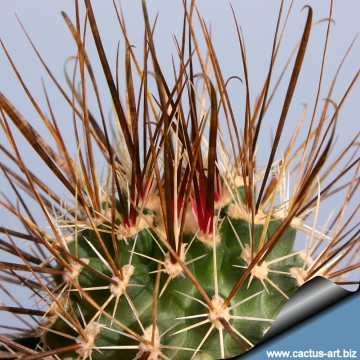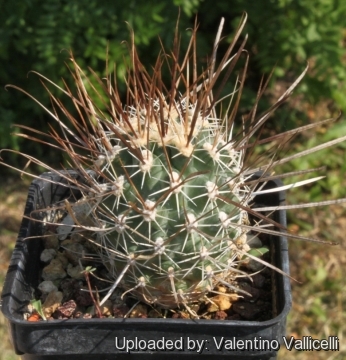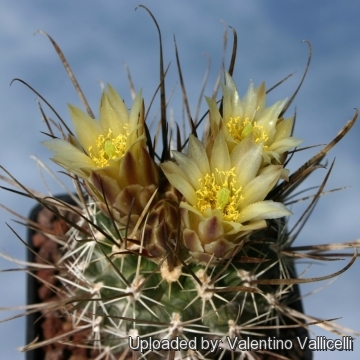Accepted Scientific Name: Sclerocactus hybrid papyracanthus x parviflorus

Toumeya hybrid cv. papyracantha x Sclerocactus parviflorus (Sclerocactus hybrid papyracanthus x parviflorus) Photo by: Valentino Vallicelli
This plant has very long flat ± papery spines that are intermediate in shape to those of the parents. The centrals are brown with the new growth of a bright red colour, the radials are short and pure white.
Origin and Habitat: Garden origin (Nursery produced hybrid)
Synonyms:
Description: Habit: Solitary.
Stem: Green, up to 20 cm tall and 6-12 cm in diameter. It has vertical ribs with elongate tubercles.
Areoles: 0.1-0.5 cm in diameter at the summits of the tubercles, and generally 0.3-1,5 cm apart. Glands, which are homologous with spines, are frequently on the adaxial sides of areoles which do not produce flowers
Spines: Central spines usually 3-4, flattened, ± flexible, grooved, twisted, papery in texture, 4-5 cm long. Often obscuring the surface of the stem. Radial spines parallel to the stem surface, 6-8 per cluster, ashy-white, 3-9 mm long.
Flower: On the new growth of the current season near the apex of the stem. Yellowhis, bell-shaped, with a brownish central midstripe, 2.5-4.5 cm wide.
Fruit: Green, often changing to tan, spherical, 1.2-2.0 cm long, dry and dehiscent at maturity along a dorsal slit and around the circumscissile apex.
Phenology: Blooming time April/May
Subspecies, varieties, forms and cultivars of plants belonging to the Sclerocactus papyracanthus group
 Toumeya hybrid cv. papyracantha x Sclerocactus parviflorus (Sclerocactus hybrid papyracanthus x parviflorus) Photo by: Cactus Art
Toumeya hybrid cv. papyracantha x Sclerocactus parviflorus (Sclerocactus hybrid papyracanthus x parviflorus) Photo by: Cactus Art Toumeya hybrid cv. papyracantha x Sclerocactus parviflorus (Sclerocactus hybrid papyracanthus x parviflorus) Photo by: Valentino Vallicelli
Toumeya hybrid cv. papyracantha x Sclerocactus parviflorus (Sclerocactus hybrid papyracanthus x parviflorus) Photo by: Valentino Vallicelli Toumeya hybrid cv. papyracantha x Sclerocactus parviflorus (Sclerocactus hybrid papyracanthus x parviflorus) Photo by: Valentino Vallicelli
Toumeya hybrid cv. papyracantha x Sclerocactus parviflorus (Sclerocactus hybrid papyracanthus x parviflorus) Photo by: Valentino Vallicelli Toumeya hybrid cv. papyracantha x Sclerocactus parviflorus (Sclerocactus hybrid papyracanthus x parviflorus) Photo by: Cactus Art
Toumeya hybrid cv. papyracantha x Sclerocactus parviflorus (Sclerocactus hybrid papyracanthus x parviflorus) Photo by: Cactus ArtCultivation and Propagation: Needs moderate watering, because excess of water causes mature individuals to rot and die, especially after transplanting.
Sun Exposure: Full sun to partial shade.
Cultural Practices: Needs a very draining and mineral substratum.
Frost Tolerance: Very frost hardy, above approx -12° C.
Propagation: Seeds. Temperature for optimum germination: night minimum approx 17 day maximum, up to nearly 40 C, at any time of year with proper temperatures and daylength (ca.13-14 hours); it is possible to extend day-length with artificial lights. Anyway the seeds germinate slowly with extreme difficulty and a low rate of success. scarification and stratification help, alternately freeze and thaw both wet and dry, but don’t keep wet, alternate wet and dry with changing temperatures. Germination can take several years, so keep pot and try again next year. Seedlings do not do well either, and some die each year, for this reason plants are commonly grafted on hardy stocks like Opuntia compressa. In this case they are easy to grow and no special skill is required.














